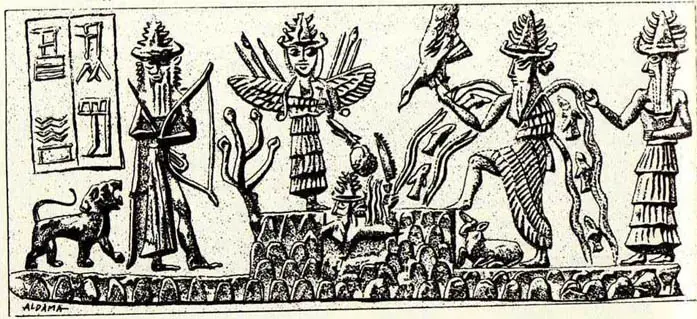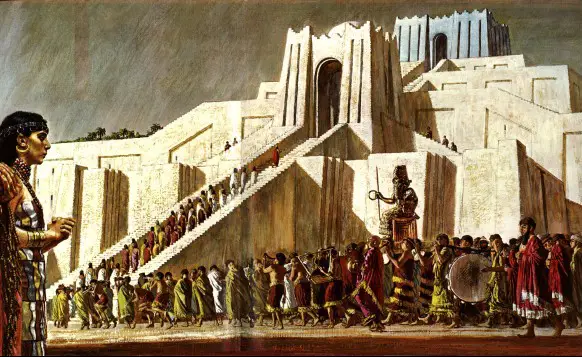Through the mythical re-actualization of the clash between the god Marduk and the "sea monster" Tiamat, the Akītu was configured, in the final analysis, following the studies of Mircea Eliade, as a collective rite of passage: at the beginning of the new year, through the ritual and recitation of the ancient cosmogonic poem Enûma Elish, time and space were "refounded".
di Maurilio Ginex
It is possible to learn from the lesson of Mircea Eliade a differentiation between what Sacred Time represents and what is defined as Profane Time. The latter is identified with the normal pace of time within the life of a man who is distinguished by what falls within the temporal dimension of the sacred through the recurrence of religious-based feasts that represent a form of caesura of time, a rupture in ordinary time.
The feasts, made up of articulated rituals that recall, in their periodic manifestation, the importance of myth in the social context, become a way to pass, without any danger, from profane time to sacred time and vice versa. In this regard Eliade himself says (The sacred and the profane, p. 47):
«Participating religiously in a party means leaving the“ normal ”temporal duration and reintegrating the mythical time re-actualized by the party itself. "
That which falls within the dimension of the sacred whose manifestation is defined as hierophany, which means precisely «manifestation of the sacred ", embraces a very varied mass of facts. A ritual, a myth, can be hierophanies; but what is important to highlight is the fact that time takes on sacredness by virtue of the recurrence of the event and in its continuous manifestation, never changing in its ontology. Its reiteration and its manifestation are monolithic in the sense that there is no possibility of applying temporal rationality understood as a change imposed by the becoming of time. The sacred time that transpires in a certain feast or in a certain ritual does not change its essence, it becomes a circular time whose sacredness is reintegrated through the hierophanies.
In the wake of this brief preamble on the difference between the two types of time lived by the individual, we take into analysis a historical-mythical context that in the various cultural studies that have dealt with archaic societies often appears, that is, the reality of Babylon. A city called «House of the base of heaven and earth "or" gate of the gods " (Etemenanki) (Eliad, The myth of the eternal return, p. 31), or a city from which the gods descended.

Within the Babylonian context, which in our discourse embraces the difference between profane time and sacred time, we graft a critical and explanatory look at a specific type of celebration, very ancient, dating back to the period of Babylon not only for a historical-temporal location. but for the cultural belonging of the city. This holiday is called Akitu, or the Babylonian New Year. It was the most important festival in Babylon and was an event that could only be celebrated in the presence of the king.
This festival consisted of a large structure, as its celebration took place over 12 days, in the month of Nisan (Nissanu), which is equivalent to April in the West. The Akītu represents what in the ethnological literature, by Arnold Van Gennep, has been defined rite of passage, or a hierophany that causes a transition from one state of affairs to another. A celebration that represents a rite of passage, in which time and space are refounded in the transition to the new year.
Among the 12 days that are spent on the Akītu festival, the fourth takes on a particular sacral importance since on that day, in the evening, the high priest (šešgallu) of the temple - Overdo it, a structure erected in Babylon for the king of the gods, Marduk - will recite the ancient cosmogonic poem Enûma Elish. The latter will highlight a structural aspect of the Babylonian historical-mythical story, namely the relationship between the god Marduk and the sea monster Tiamat. The poem represented the instrument through which to be able to continuously renew in the memory, through a process of ritualization, the clash between Tiamat and Marduk; clash in which the latter managed to defeat the monster by recomposing the order and defeating the Chaos.

Marduk in the history of mythology and in the ancient world represents a controversial figure, as only when Babylon becomes the political center of the Euphrates - at the hands of Hammurabi, in the second millennium BC - it assumed its positive connotations and greater importance in front of the population, so much so that it dedicated a sacred space to its mythical effigy, such as Esagila, the place where the importance of Marduk is embodied that mythologically, defeats Tiamat.
When we speak of sacred space we are implicitly speaking of a cosmogonic construction through that space. The construction represents an endless reiteration of an archetype, in the form of "primordial revelation"(Eliade, Treatise on the history of religions, p. 382). But the aspect that most interests the discourse developed here is what concerns the cosmogonic dimension, cited above, of the creation of sacred space.
In Treatise on the history of religions (1958), Eliade, when he speaks of the construction of the spatial dimension of the sacred, develops a discourse inherent in the erection of altars and sanctuaries, identifying in the construction of the same the act of a reconstruction of the cosmos, but the same cosmogonic significance can structurally be applied to any other intention of building a sacred space. As for example, in our case, the Esagila who becomes - through the reference to the figure of the sacred identified in the god Marduk - archetypal and primordial reiteration. The sacred, among the populations who, on the basis of a certain tradition of studies ranging from Eliade to Van der Leeuw, are defined as traditional or primitive, becomes something that in its reiteration and enhancement promotes a metaphysical vision of existence.
Babylonian society is precisely an example of such social systems, which see earthly reality as a form of imitation of the celestial dimension. (Eliade, The myth of the eternal return, p. 18). Therefore, another decisive aspect within an analysis process, aimed at understanding the rationality of an ancient society is represented by symbolism of the center and the importance that the latter has culturally. In this specific aspect of the Babylonian context analyzed, the centrality of the Esagila attests to its sacredness not only because it becomes a constitutive element of the ritual celebration of Akītu, but precisely because its centrality summarizes the graft between the cult of the God and passage from chaos (Tiamat present) to order (Tiamat defeated). Place, which for its specific symbolism, becomes perfectly suited to the idea of the rite of passage that is present in the New Year's party.

The forms of the sacred are innumerable, but what we must remember in the face of any analytic deconstruction that is made of it, is that every cultural phenomenon is born as an expression of a given psychic experience, to put it Leo Frobenius. Everything is subject to a thematic, conceptual, social and cultural contextualization, as well as temporal, but this contextualization must not be a symptom of implicit prejudice.
Examples such as Akītu or sacred institutions such as Esagila, represent an important fact, as in them we can read how in ancient times we do not see a hypothetical separatist discourse, on the part of the modern European, based on the presence or absence of rationality in the specific hierophanies. Instead, one can perceive how, in reality, the presence of a direct relationship with the sacred is more common. Un relationship that influences the identity of the social structure that will base its existence on the primordial and continuous relationship with a celestial dimension.
This specific aspect identifies the absolute peculiarity of pre-Socratic and archaic societies in which the sacred was consumed since the everyday. That sacred that alludes to a dimension in which it exists the importance of repetition, through which societies re-establish mythical time and the validity of ritual space - as the center represented by the Hexagila in the discourse carried out - for the purpose of a total self-awareness that continually highlights the relationship with the transcendent.
Finally, on a horizon in which the sacred acquires its own specific space even in everyday life, it is crucial to identify how the myth acquires an importance of particular importance, since it is in it that the origin of that sacred dimension must be found. The myth tells how the facts have evolved in a primordial form and through it we can trace the identification of a culture, deconstructing the habits and customs of a people. So, the myth represents something total in relation to the identity of the social system to which it belongs and from it the morphology - symbolic and cultural - of the various festive rituals can be identified.

Bibliography:
- ELIAS, Mircea: The myth of the eternal return, 1949
- ELIAS, Mircea: The sacred and the profane, 1959
- ELIAS, Mircea: Treatise on the history of religions, 1958
